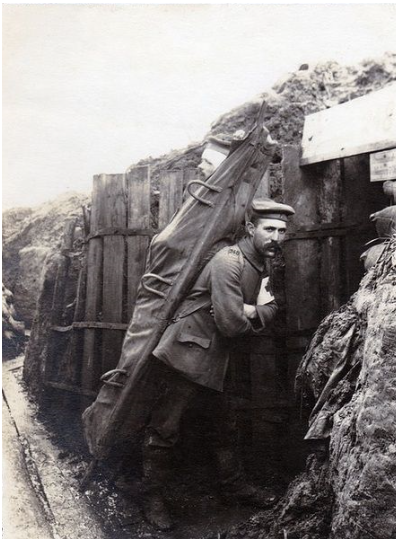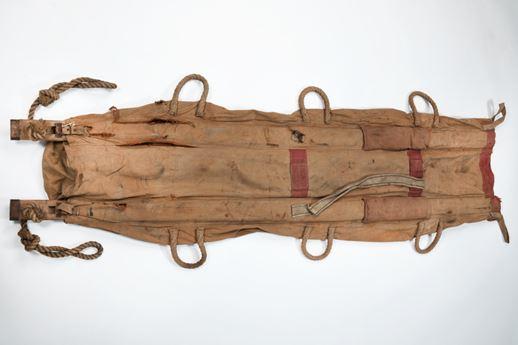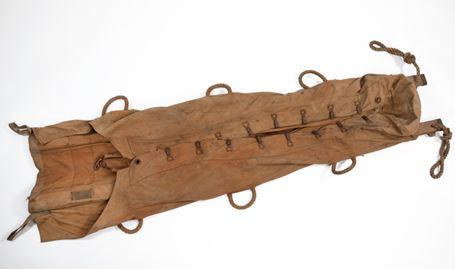A very rare stretcher
Covid-19 and the need to maintain physical distance yielded some interesting results at the Memorial. Objects curators had the opportunity to spend more time at our storage facility, working with legacy acquisitions that required photography or further description.
On a pallet at the Memorial’s Treloar Technology Centre is a very rare stretcher. It is a rare German First World War stretcher designed to be carried through a trench on the back of a single bearer.

A German stretcher bearer of Reserve Infantry Regiment 248 carrying a patient to an Aid Post. The stretcher pictured has nearly identical features to the one held by the Australian War Memorial. RELAWM00963.
The Australian War Memorial, and the military museums of Europe and North America, have many First World War stretchers in their collections. Some are designed to be dragged behind horses, others carried on camels; there are stretchers to be loaded onto motorcycle sidecars, ships or railway trolleys; others are a simple blanket and pole arrangement. Some bear the marks of violence; some are stained with blood.
After contacting the world’s major war museums I could not establish the existence of another stretcher of this type. That is not to say there are no examples elsewhere; simply that there are no known surviving specimens in the principal military museums.*
The Memorial’s stretcher is made of camel-coloured flexible canvas, supported longitudinally by two wooden planks. It has a closable double-flap canvas body to encompass the patient. The 'feet' end of the stretcher is sewn into a bag-like pocket.
Attached to the internal bed is a padded V shaped harness designed to pass between the legs of the patient and secure him over the waist. The outer canvas flaps have an offset hook and eyelet system so they can be laced together using cord or wire.
This is a stretcher that secures and cocoons the patient.
On the underside of the stretcher are the remnants of two shoulder straps - one has been torn off - in dirty white cotton webbing. Next to the straps are wadded rectangular pads sewn to the body of the stretcher to cushion the shoulders of the bearer. The stretcher also has three rope handles on either side for carrying, and two more at either end.
Sewn to an inner flap is a printed fabric square of writing in Gothic font. This small square of text is the stretcher User Manual and the key to the stretchers various applications. It describes in German how to carry a patient with no lower limb injuries:
“In narrow passages, two men carry the stretcher horizontally. In angled or zigzag passages the stretcher is carried upright, slowly and carefully by a single carrier on his back using shoulder straps.”

Underside of the stretcher. Carrying a wounded man upright on a wood and canvas frame would have been possible only for short distances, and solely on solid ground. Deep mud, barbed wire, and shell holes were features of the Western Front.

Once harnessed in, the flaps fold over the injured soldier, and he is laced tightly in.
The stretcher was collected by three men of the 20th Battalion for a proposed 20 Battalion museum. They were Privates William Wise and Bailey Kent, and Sergeant Walter Brown VC DCM. Private Wise was good enough to leave his autograph and give the object provenance: on the inside of one inner flap is inked “W. H. Wise 20th Bn Pioneers”.
Lest there be any doubt, nailed into one of the wooden planks is a small brass plate impressed with the text “GERMAN TRENCH STRETCHER CAPTURED BY 20TH AUST INF BATTALION AT MT ST QUENTIN ON THE SOMME FRANCE 31.8.18.”
The men of the 20th Battalion were quite the collectors. The group captured many objects that came to our collection. These include German identity discs, helmets and water bottles; a klaxon, signboards, weapons and tools. Happily, they even souvenired a German moustache trainer.

Identifying their loot: a brass plate (flattened artillery shell) attached to the stretcher. The letters are impressed with a steel stamping kit, designed for stamping identification discs or dog tags.
“The distinction of being the one millionth visitor [to the Australian War Museum in Sydney] is held by Mr W E Brown, VC, DCM, seen entering the Exhibition at Prince Alfred Park Sydney.” Though the 1927 catalogue does not confirm it, it is highly likely that Brown viewed some of his own ‘collection’ souvenired for the proposed 20 Battalion museum.
Stretchers of the First World War were many and varied. Though different in design and material, they typically share two features : they were made to remove the wounded and dead from the battlefield, and (unless carried by a vehicle or animal) they were always carried by two or more bearers.
This ingenious design that allows a single stretcher-bearer to carry a wounded man on his back for short distances is unique. The German trench stretcher sitting at the Treloar Technology Centre in the Canberra suburb of Mitchell, is quite probably the only one of its kind in the world.
23 September 2020 Emily Gibbs
*18 museums and collecting institutions in Britain, France, Germany, Belgium, Canada, United States and New Zealand were contacted. All responded.
